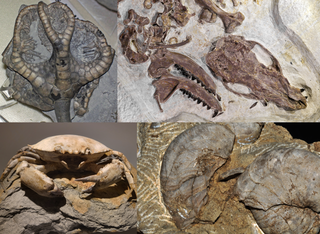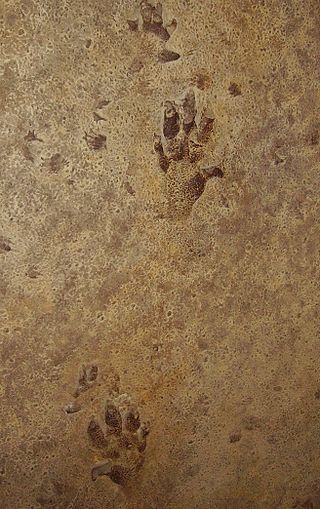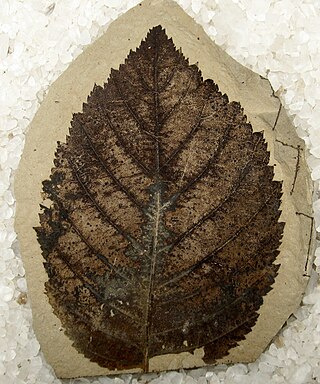
A fossil is any preserved remains, impression, or trace of any once-living thing from a past geological age. Examples include bones, shells, exoskeletons, stone imprints of animals or microbes, objects preserved in amber, hair, petrified wood and DNA remnants. The totality of fossils is known as the fossil record.

Paleontology, also spelled palaeontology or palæontology, is the scientific study of life that existed prior to, and sometimes including, the start of the Holocene epoch. It includes the study of fossils to classify organisms and study their interactions with each other and their environments. Paleontological observations have been documented as far back as the 5th century BC. The science became established in the 18th century as a result of Georges Cuvier's work on comparative anatomy, and developed rapidly in the 19th century. The term has been used since 1822 formed from Greek παλαιός, ὄν, and λόγος.

In biology, a spore is a unit of sexual or asexual reproduction that may be adapted for dispersal and for survival, often for extended periods of time, in unfavourable conditions. Spores form part of the life cycles of many plants, algae, fungi and protozoa. They were thought to have appeared as early as the mid-late Ordovician period as an adaptation of early land plants.

Taphonomy is the study of how organisms decay and become fossilized or preserved in the paleontological record. The term taphonomy was introduced to paleontology in 1940 by Soviet scientist Ivan Efremov to describe the study of the transition of remains, parts, or products of organisms from the biosphere to the lithosphere.

Timeline of paleontology

Invertebrate paleontology is sometimes described as invertebrate paleozoology or invertebrate paleobiology. Whether it is considered to be a subfield of paleontology, paleozoology, or paleobiology, this discipline is the scientific study of prehistoric invertebrates by analyzing invertebrate fossils in the geologic record.

Palynology is the study of microorganisms and microscopic fragments of mega-organisms that are composed of acid-resistant organic material and occur in sediments, sedimentary rocks, and even some metasedimentary rocks. Palynomorphs are the microscopic, acid-resistant organic remains and debris produced by a wide variety plants, animals, and Protista that have existed since the late Proterozoic.

A trace fossil, also known as an ichnofossil, is a fossil record of biological activity by lifeforms but not the preserved remains of the organism itself. Trace fossils contrast with body fossils, which are the fossilized remains of parts of organisms' bodies, usually altered by later chemical activity or mineralization. The study of such trace fossils is ichnology and is the work of ichnologists.

Paleobotany, also spelled as palaeobotany, is the branch of botany dealing with the recovery and identification of plant remains from geological contexts, and their use for the biological reconstruction of past environments (paleogeography), and the evolutionary history of plants, with a bearing upon the evolution of life in general. A synonym is paleophytology. It is a component of paleontology and paleobiology. The prefix palaeo- or paleo- means "ancient, old", and is derived from the Greek adjective παλαιός, palaios. Paleobotany includes the study of terrestrial plant fossils, as well as the study of prehistoric marine photoautotrophs, such as photosynthetic algae, seaweeds or kelp. A closely related field is palynology, which is the study of fossilized and extant spores and pollen.

Micropaleontology is the branch of paleontology (palaeontology) that studies microfossils, or fossils that require the use of a microscope to see the organism, its morphology and its characteristic details.

Paleoecology is the study of interactions between organisms and/or interactions between organisms and their environments across geologic timescales. As a discipline, paleoecology interacts with, depends on and informs a variety of fields including paleontology, ecology, climatology and biology.

A coprolite is fossilized feces. Coprolites are classified as trace fossils as opposed to body fossils, as they give evidence for the animal's behaviour rather than morphology. The name is derived from the Greek words κόπρος and λίθος. They were first described by William Buckland in 1829. Before this, they were known as "fossil fir cones" and "bezoar stones". They serve a valuable purpose in paleontology because they provide direct evidence of the predation and diet of extinct organisms. Coprolites may range in size from a few millimetres to over 60 centimetres.

Palaeozoology, also spelled as Paleozoology, is the branch of paleontology, paleobiology, or zoology dealing with the recovery and identification of multicellular animal remains from geological contexts, and the use of these fossils in the reconstruction of prehistoric environments and ancient ecosystems.

A microfossil is a fossil that is generally between 0.001 mm and 1 mm in size, the visual study of which requires the use of light or electron microscopy. A fossil which can be studied with the naked eye or low-powered magnification, such as a hand lens, is referred to as a macrofossil.

Paleobiology is an interdisciplinary field that combines the methods and findings found in both the earth sciences and the life sciences. Paleobiology is not to be confused with geobiology, which focuses more on the interactions between the biosphere and the physical Earth.

The history of paleontology traces the history of the effort to understand the history of life on Earth by studying the fossil record left behind by living organisms. Since it is concerned with understanding living organisms of the past, paleontology can be considered to be a field of biology, but its historical development has been closely tied to geology and the effort to understand the history of Earth itself.

Taxonomy of commonly fossilized invertebrates combines both traditional and modern paleozoological terminology. This article provides an overview of various invertebrate taxa found in the fossil record, ranging from protists to arthropods. The taxonomy discussed emphasizes invertebrates that are either frequently collected as fossils or are extinct. This includes groups that are significant in paleontological contexts, abundant in the fossil record, or have a high proportion of extinct species. Special notations are explained below:
Paleontology or palaeontology is the study of prehistoric life forms on Earth through the examination of plant and animal fossils. This includes the study of body fossils, tracks (ichnites), burrows, cast-off parts, fossilised feces (coprolites), palynomorphs and chemical residues. Because humans have encountered fossils for millennia, paleontology has a long history both before and after becoming formalized as a science. This article records significant discoveries and events related to paleontology that occurred or were published in the year 1937.

Fungi diverged from other life around 1.5 billion years ago, with the glomaleans branching from the "higher fungi" (dikaryans) at ~570 million years ago, according to DNA analysis. Fungi probably colonized the land during the Cambrian, over 500 million years ago,, and possibly 635 million years ago during the Ediacaran, but terrestrial fossils only become uncontroversial and common during the Devonian, 400 million years ago.
Paleomycology is the study of fossil fungi. Paleomycology is considered a subdiscipline of paleobotany, centered on mushrooms, fungal spores, and hyphae preserved in sediment layers and rock. Fungi have been found in the palaeoecological record as far back as the Paleozoic era, with evidence of influencing the evolutionary processes of early flowering plants.

















